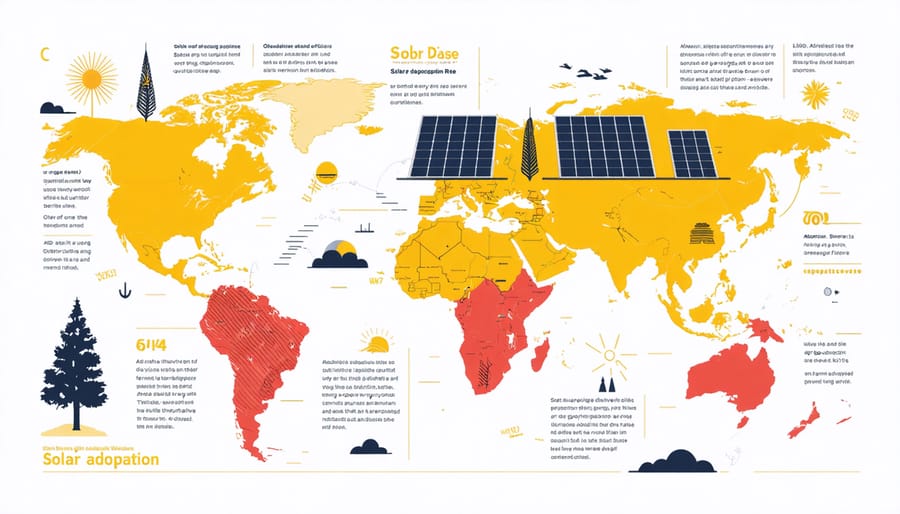In today’s interconnected marketplace, navigating cultural paradoxes has become the cornerstone of successful global marketing campaigns. As global power shifts in solar energy reshape international business dynamics, understanding these complex cultural nuances is no longer optional—it’s imperative for survival.
Marketing professionals face a distinctive challenge: balancing standardization with localization while maintaining brand consistency across diverse cultural landscapes. What resonates in New York may fall flat in Tokyo, and strategies that drive engagement in Dubai might alienate audiences in Stockholm. These cultural paradoxes—simultaneous desires for tradition and modernity, individual expression and collective harmony, global connectivity and local identity—define the modern marketing landscape.
This complexity demands a sophisticated approach that transcends traditional marketing frameworks. Successful global brands have learned to decode these paradoxes, transforming potential barriers into strategic advantages. They recognize that effective cross-cultural marketing isn’t about choosing between global standardization and local adaptation—it’s about masterfully orchestrating both.
Through careful analysis of cultural paradoxes, brands can create marketing strategies that resonate deeply with diverse audiences while maintaining operational efficiency and brand consistency. This strategic balance holds the key to unlocking sustainable global market success.
Cultural Paradoxes in Solar Energy Marketing
Tradition vs. Innovation
The intersection of traditional values and renewable energy adoption presents a fascinating paradox in global marketing. In many traditional societies, the concept of harmony with nature aligns perfectly with solar energy principles, yet resistance to new technology can create barriers to adoption. Marketing professionals must navigate this delicate balance by emphasizing how solar technology complements, rather than conflicts with, cultural values.
For example, in Japan, the traditional concept of ‘mottainai’ (avoiding waste) has been successfully linked to solar energy efficiency, resulting in higher adoption rates. Similarly, Middle Eastern countries have connected their historical reliance on the sun with modern solar technology, creating a narrative bridge between heritage and innovation.
Successful marketing campaigns often highlight how solar technology enhances traditional practices rather than replacing them. This approach has proven particularly effective in agricultural communities, where solar-powered irrigation systems build upon generations-old farming techniques. By positioning renewable energy as an evolution of traditional resource management rather than a revolution, marketers can overcome initial resistance and build trust with traditionally-minded stakeholders.

Individual vs. Collective Benefits
In global marketing, understanding the delicate balance between individual and collective benefits is crucial for successful campaign development. Western markets typically emphasize personal achievement and individual advantages, where marketing messages focus on self-improvement, personal status, and individual success. For instance, luxury brands in the United States often highlight personal distinction and exclusive benefits.
Conversely, many Asian and African cultures prioritize collective well-being and community harmony. Marketing campaigns in these regions are more effective when they demonstrate how products or services benefit the entire family, community, or society. Japanese advertisements frequently showcase group consensus and social harmony rather than individual achievement.
Successful global marketers adapt their messaging to reflect these cultural nuances while maintaining brand consistency. For example, automotive companies might emphasize personal freedom and status in individualistic markets while focusing on family safety and community respect in collectivist societies. This strategic approach requires careful consideration of cultural values and social structures to create resonant marketing messages that align with local perspectives on individual and collective benefits.

Regional Marketing Adaptations
Asian Markets: Balancing Face and Functionality
In Asian markets, successful marketing strategies often navigate the delicate balance between maintaining “face” (social status and reputation) and delivering practical value. Companies like Samsung have masterfully addressed this cultural paradox in their solar energy campaigns by emphasizing both prestige and performance. Their approach combines luxury positioning with detailed technical specifications, appealing to status-conscious consumers while validating their practical decision-making.
Toyota’s solar initiatives in Japan demonstrate another effective approach. Their marketing emphasizes how solar technology enhances social responsibility and environmental leadership, while simultaneously highlighting cost savings and efficiency metrics. This dual messaging resonates with Asian consumers who seek both social validation and tangible benefits.
In emerging solar markets like Vietnam and Thailand, successful campaigns often feature respected community leaders and business figures alongside detailed ROI calculations. This strategy satisfies the need for social proof while addressing practical considerations.
LG’s solar marketing in South Korea exemplifies this balance through their “Smart Prestige” campaign. By positioning solar installations as both a status symbol and a wise investment, they’ve achieved remarkable market penetration. Their approach includes showcasing high-profile installations at prestigious buildings while providing comprehensive performance data and savings calculations, effectively bridging the gap between face and functionality.
Western Markets: Environmental Leadership and ROI
In Western markets, environmental leadership has evolved beyond simple green messaging to become intrinsically linked with return on investment (ROI). This dual focus reflects a fascinating cultural paradox where consumers simultaneously demand environmental responsibility and financial prudence. Successful marketing campaigns in these regions effectively bridge this gap by highlighting both sustainability credentials and economic benefits.
Recent market research indicates that 73% of Western consumers are more likely to engage with brands that demonstrate measurable environmental impact alongside clear cost savings. This has led to sophisticated messaging strategies that showcase how global supply chain adaptations contribute to both environmental goals and business efficiency.
Companies that effectively navigate this paradox typically employ a three-pronged approach: quantifying environmental impact in business terms, demonstrating long-term cost benefits, and highlighting innovation leadership. For instance, successful solar energy marketing campaigns in Western Europe consistently emphasize carbon reduction metrics alongside energy cost savings projections, creating a compelling narrative that satisfies both environmental and financial concerns.
The key to success lies in maintaining authenticity while addressing both aspects of this cultural dynamic. Marketing messages that transparently acknowledge the relationship between environmental stewardship and financial performance tend to resonate most strongly with Western audiences, particularly in the B2B sector.
Navigating Cultural Communication Barriers
Visual Communication Across Cultures
Visual communication in global marketing requires careful consideration of cultural nuances and symbolism. Successful brands adapt their visual elements to resonate with local audiences while maintaining global consistency. Color selection is particularly crucial, as colors carry different meanings across cultures. For example, while white represents purity in Western cultures, it symbolizes mourning in many Asian countries.
Images and symbols must be thoroughly vetted for cultural appropriateness. Simple gestures or icons that are innocuous in one culture may be offensive in another. Graphics should reflect local demographics, family structures, and social norms while avoiding stereotypes.
Layout and design preferences also vary significantly. Western markets often prefer minimalist designs with substantial white space, while many Asian markets respond better to information-dense layouts with vibrant visuals.
Best practices include:
– Conducting local market research before finalizing designs
– Using culturally appropriate models and scenarios
– Testing visual elements with local focus groups
– Maintaining brand consistency while adapting to local preferences
– Ensuring proper translation of text elements within visuals
– Considering religious and social taboos in imagery selection
These considerations help prevent costly marketing mistakes and ensure effective cross-cultural communication.
Message Localization Strategies
Successful message localization requires a strategic balance between maintaining brand consistency and adapting to local cultural nuances. Companies should implement a three-tier approach to message adaptation: universal core values, regional modifications, and local customization. This framework allows organizations to preserve their brand identity while resonating with diverse cultural audiences.
Key adaptation techniques include working with local cultural consultants to validate messaging, utilizing transcreation rather than direct translation, and conducting local market testing before full campaign deployment. Organizations should pay particular attention to color symbolism, imagery selection, and linguistic nuances that may carry different meanings across cultures.
Digital analytics tools can help track message effectiveness across different cultural contexts, enabling real-time adjustments based on audience response. Companies should develop cultural adaptation guidelines that consider both verbal and non-verbal communication elements, including tone, humor, and visual hierarchy.
A systematic review process involving local stakeholders helps ensure marketing messages maintain their intended impact while avoiding cultural misunderstandings or offense. This collaborative approach strengthens brand credibility and builds lasting connections with local audiences.
Building Trust Across Cultural Boundaries
Local Partnerships and Validation
Establishing strong local partnerships is crucial for navigating cultural complexities in global marketing campaigns. These partnerships provide invaluable insights into market-specific nuances and help validate marketing approaches before full-scale implementation. As cross-border solar investments continue to grow, successful companies increasingly rely on local expertise to ensure cultural authenticity and market relevance.
Local partners serve as cultural interpreters, helping brands avoid potential missteps while enhancing credibility within target markets. They provide real-time feedback on campaign elements, from messaging to visual design, ensuring cultural sensitivity and market appropriateness. This validation process helps identify subtle cultural nuances that might otherwise be overlooked in broader market research.
Furthermore, local partnerships facilitate authentic community engagement and help build trust with target audiences. By collaborating with established local entities, companies can demonstrate their commitment to understanding and respecting local cultures while creating marketing campaigns that genuinely resonate with local consumers. This approach not only minimizes cultural risks but also maximizes marketing effectiveness through locally-validated strategies and execution.

Cultural Sensitivity in Customer Service
Customer service expectations vary significantly across cultures, requiring businesses to adapt their approach to meet local preferences and customs. In high-context cultures like Japan and China, indirect communication and relationship-building take precedence, while low-context cultures such as the United States and Germany prefer direct, efficient problem-solving approaches.
Successful global businesses implement culturally-sensitive training programs that teach service representatives to recognize and respond appropriately to cultural cues. This includes understanding proper forms of address, communication styles, and conflict resolution methods specific to each market. For instance, Middle Eastern cultures often expect more personalized service and relationship development, while Northern European markets typically value efficiency and straightforward solutions.
Time perception also plays a crucial role in customer service delivery. Some cultures expect immediate responses and quick resolutions, while others prioritize thoroughness and careful consideration over speed. Organizations must align their service level agreements and response times with these cultural expectations while maintaining consistent quality standards across all markets.
Training customer service teams in cultural intelligence (CQ) has become a strategic imperative for global businesses, directly impacting customer satisfaction and brand loyalty in international markets.
Successfully navigating cultural paradoxes in global solar marketing requires a balanced, nuanced approach that acknowledges both universal sustainability values and local cultural nuances. The key to success lies in developing flexible marketing strategies that can adapt to different cultural contexts while maintaining consistent core messaging about solar energy’s benefits.
Several actionable takeaways emerge from our analysis. First, marketers must conduct thorough cultural research before entering new markets, focusing on both explicit cultural elements and underlying value systems. Second, marketing messages should be localized beyond mere translation, incorporating cultural symbols, values, and communication styles that resonate with target audiences.
To implement these insights effectively, organizations should:
– Develop cross-cultural marketing teams that bring diverse perspectives to strategy development
– Create adaptable marketing frameworks that allow for local customization while maintaining brand consistency
– Invest in ongoing cultural training and market research
– Build relationships with local partners who understand market nuances
– Regular testing and refinement of marketing approaches based on performance metrics
The future of global solar marketing lies in finding the sweet spot between standardization and localization. By understanding and effectively addressing cultural paradoxes, companies can build stronger connections with diverse audiences while advancing the universal goal of sustainable energy adoption.
Remember that successful global marketing in the solar industry isn’t about choosing between global and local approaches – it’s about skillfully combining both to create compelling, culturally relevant campaigns that drive results.

